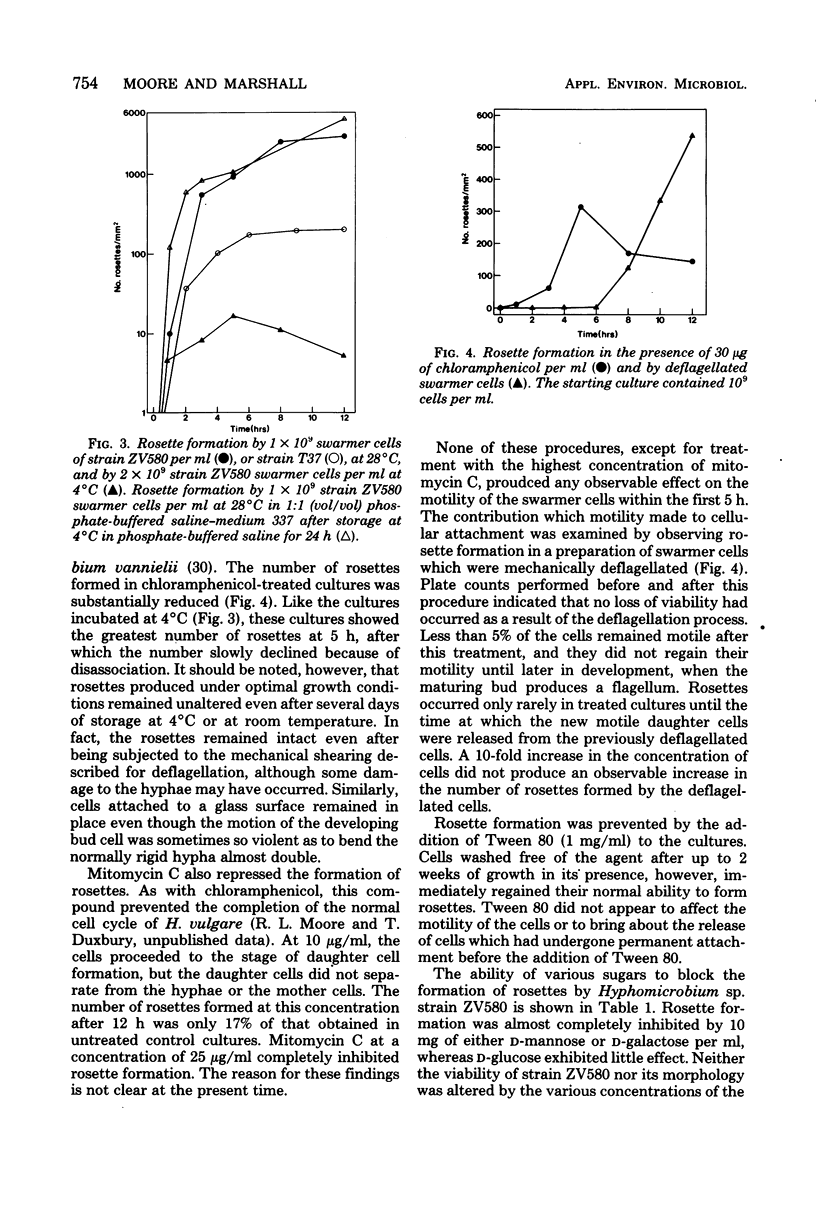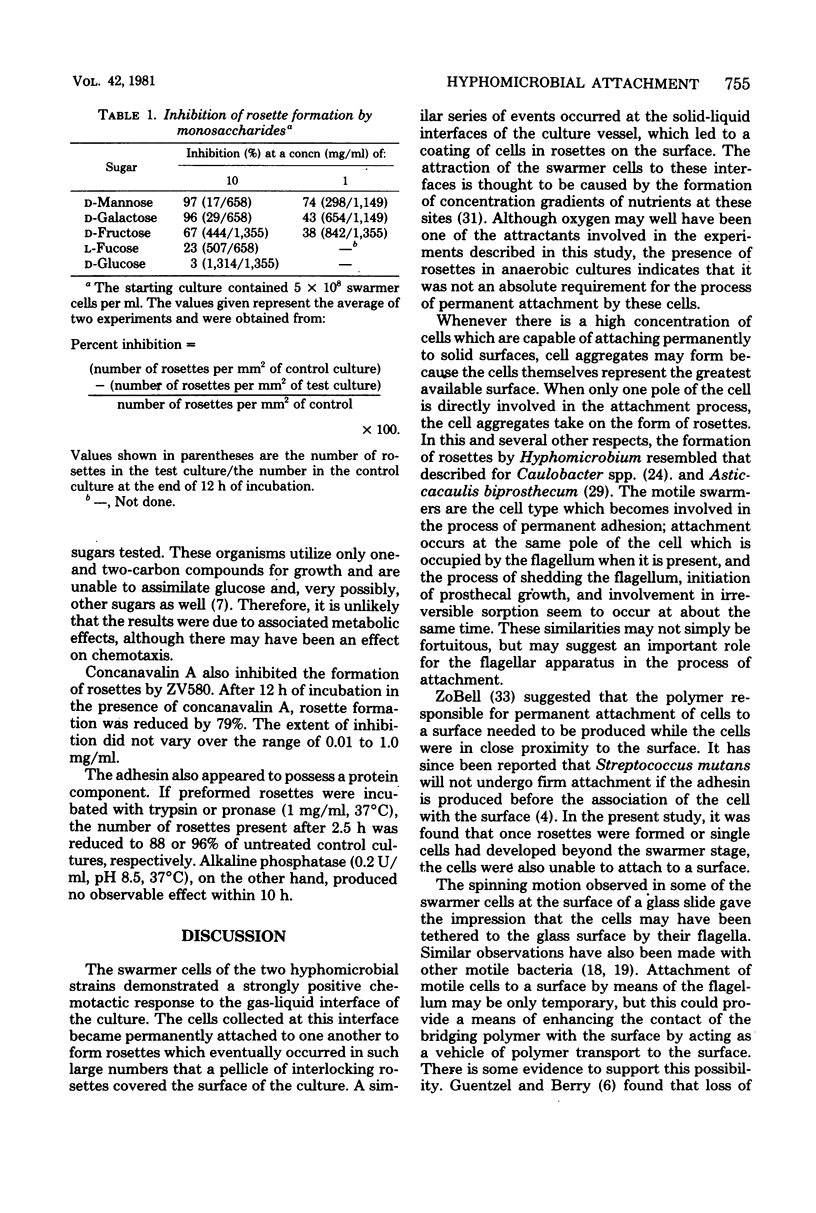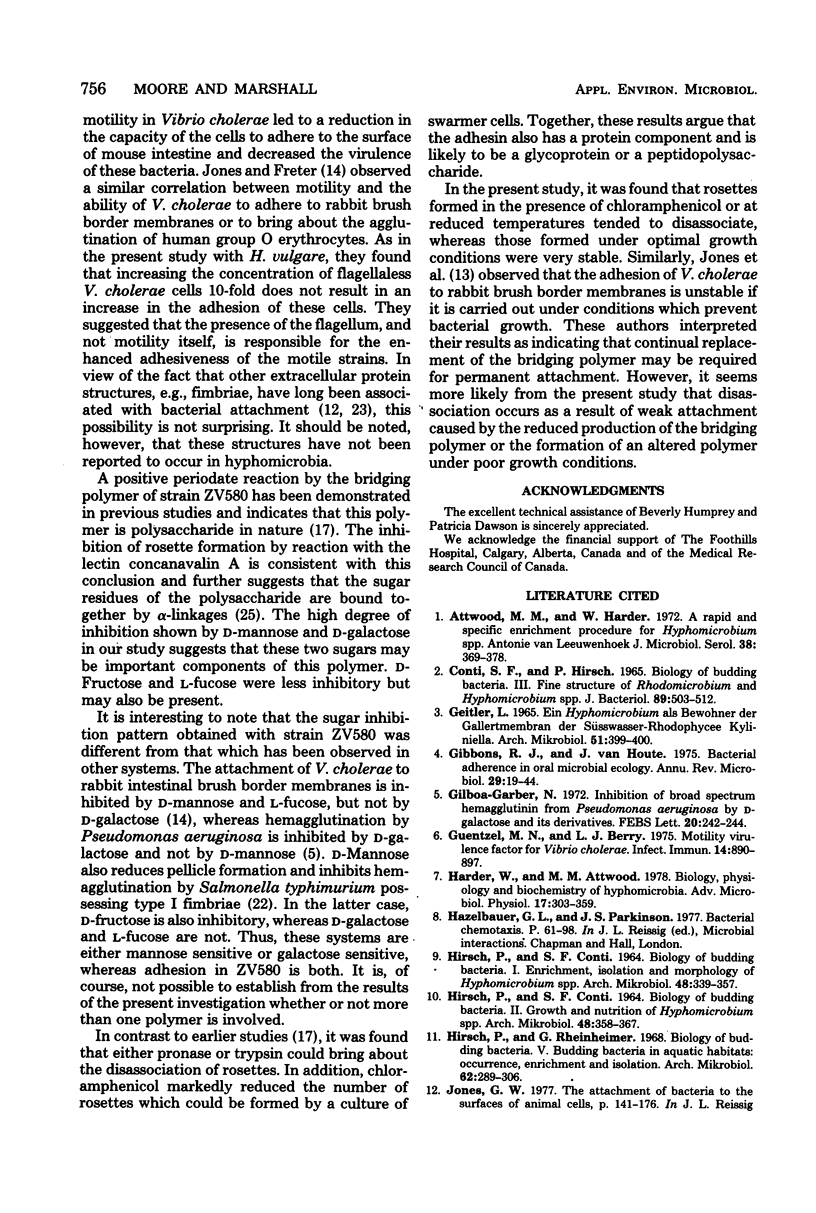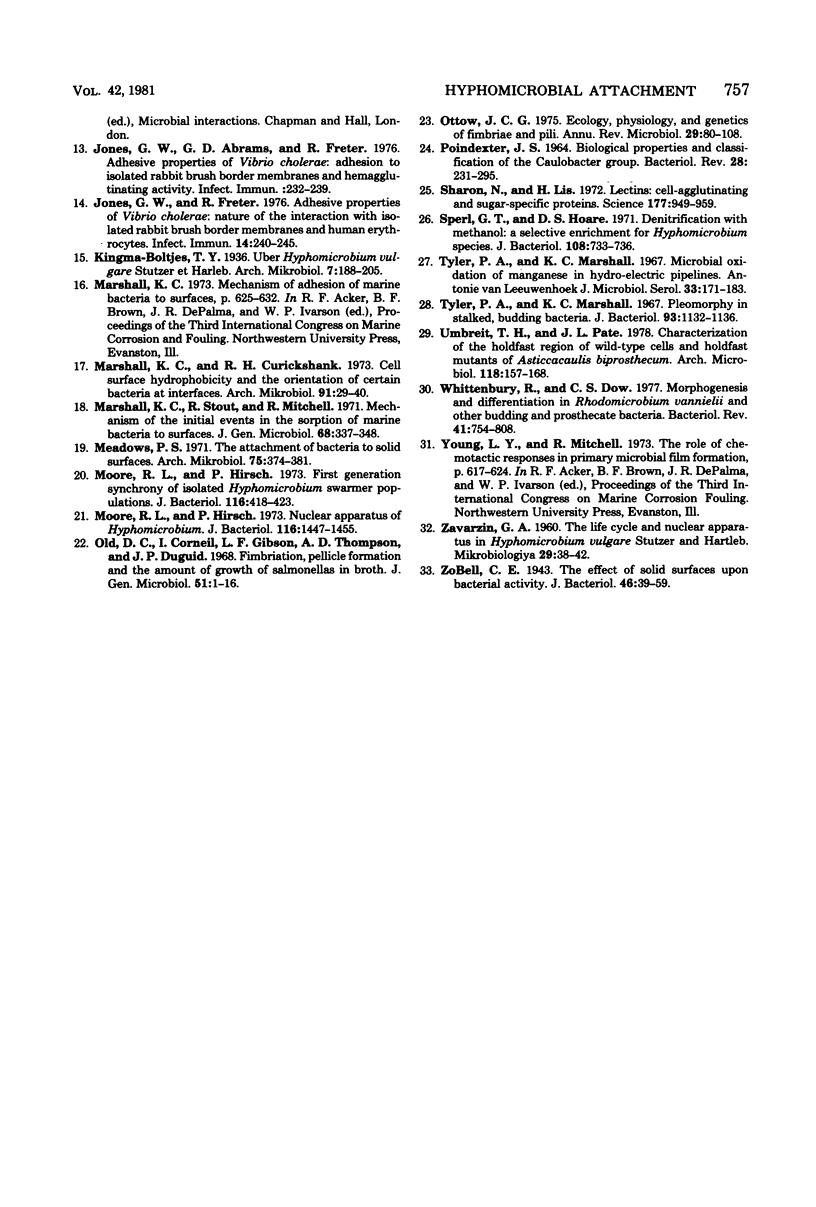Abstract
The processes of reversible and irreversible sorption of Hyphomicrobium sp. strain ZV580 to solid surfaces was investigated with the use of swarmer cell populations. Various compounds and physical conditions were examined for their effect on the cell-cell interactions which lead to the formation of rosette-like cell aggregates. The monosaccharides galactose and mannose were able to completely inhibit rosette formation. Concanavalin A and chloramphenicol were also able to prevent rosette formation, and both trypsin and pronase caused the disassociation of rosettes. The results indicate that the adhesin is a glycoprotein or a peptido-polysaccharide and that the flagellum may act as a vehicle for the transport of this adhesin from the cell to a surface.
Full text
PDF






Images in this article
Selected References
These references are in PubMed. This may not be the complete list of references from this article.
- Attwood M. M., Harder W. A rapid and specific enrichment procedure for Hyphomicrobium spp. Antonie Van Leeuwenhoek. 1972;38(3):369–377. doi: 10.1007/BF02328108. [DOI] [PubMed] [Google Scholar]
- CONTI S. F., HIRSCH P. BIOLOGY OF BUDDING BACTERIA. 3. FINE STRUCTURE OF RHODOMICROBIUM AND HYPHOMICROBIUM SPP. J Bacteriol. 1965 Feb;89:503–512. doi: 10.1128/jb.89.2.503-512.1965. [DOI] [PMC free article] [PubMed] [Google Scholar]
- Geitler L. Ein Hyphomicrobium als Bewohner der Gallertmembran der Süsswasser-Rhodophycee Kyliniella. Arch Mikrobiol. 1965 Aug 17;51(4):399–400. [PubMed] [Google Scholar]
- Gibbons R. J., Houte J. V. Bacterial adherence in oral microbial ecology. Annu Rev Microbiol. 1975;29:19–44. doi: 10.1146/annurev.mi.29.100175.000315. [DOI] [PubMed] [Google Scholar]
- Gilboa-Garber Nechama. Inhibition of broad spectrum hemagglutinin from Pseudomonas aeruginosa by D-galactose and its derivatives. FEBS Lett. 1972 Feb 1;20(2):242–244. doi: 10.1016/0014-5793(72)80805-6. [DOI] [PubMed] [Google Scholar]
- Guentzel M. N., Berry L. J. Motility as a virulence factor for Vibrio cholerae. Infect Immun. 1975 May;11(5):890–897. doi: 10.1128/iai.11.5.890-897.1975. [DOI] [PMC free article] [PubMed] [Google Scholar]
- HIRSCH P., CONTI S. F. BIOLOGY OF BUDDING BACTERIA. I. ENRICHMENT, ISOLATION AND MORPHOLOGY OF HYPHOMICROBIUM SPP. Arch Mikrobiol. 1964 Jun 26;48:339–357. doi: 10.1007/BF00405978. [DOI] [PubMed] [Google Scholar]
- HIRSCH P., CONTI S. F. BIOLOGY OF BUDDING BACTERIA. II. GROWTH AND NUTRITION OF HYPHOMICROBIUM SPP. Arch Mikrobiol. 1964 Jun 26;48:358–367. doi: 10.1007/BF00405979. [DOI] [PubMed] [Google Scholar]
- Harder W., Attwood M. M. Biology, physiology and biochemistry of hyphomicrobia. Adv Microb Physiol. 1978;17:303–359. doi: 10.1016/s0065-2911(08)60060-0. [DOI] [PubMed] [Google Scholar]
- Hirsch P., Rheinheimer G. Biology of budding bacteria. V. Budding bacteria in aquatic habitats: occurrence, enrichment and isolation. Arch Mikrobiol. 1968;62(4):289–306. [PubMed] [Google Scholar]
- Jones G. W., Abrams G. D., Freter R. Adhesive properties of Vibrio cholerae: adhesion to isolated rabbit brush border membranes and hemagglutinating activity. Infect Immun. 1976 Jul;14(1):232–239. doi: 10.1128/iai.14.1.232-239.1976. [DOI] [PMC free article] [PubMed] [Google Scholar]
- Jones G. W., Freter R. Adhesive properties of Vibrio cholerae: nature of the interaction with isolated rabbit brush border membranes and human erythrocytes. Infect Immun. 1976 Jul;14(1):240–245. doi: 10.1128/iai.14.1.240-245.1976. [DOI] [PMC free article] [PubMed] [Google Scholar]
- Marshall K. C., Cruickshank R. H. Cell surface hydrophobicity and the orientation of certain bacteria at interfaces. Arch Mikrobiol. 1973 Apr 8;91(1):29–40. doi: 10.1007/BF00409536. [DOI] [PubMed] [Google Scholar]
- Meadows P. S. The attachment of bacteria to solid surfaces. Arch Mikrobiol. 1971;75(4):374–381. doi: 10.1007/BF00407699. [DOI] [PubMed] [Google Scholar]
- Moore R. L., Hirsch P. First generation synchrony of isolated Hyphomicrobium swarmer populations. J Bacteriol. 1973 Oct;116(1):418–423. doi: 10.1128/jb.116.1.418-423.1973. [DOI] [PMC free article] [PubMed] [Google Scholar]
- Moore R. L., Hirsch P. Nuclear apparatus of Hyphomicrobium. J Bacteriol. 1973 Dec;116(3):1447–1455. doi: 10.1128/jb.116.3.1447-1455.1973. [DOI] [PMC free article] [PubMed] [Google Scholar]
- Old D. C., Corneil I., Gibson L. F., Thomson A. D., Duguid J. P. Fimbriation, pellicle formation and the amount of growth of salmonellas in broth. J Gen Microbiol. 1968 Apr;51(1):1–16. doi: 10.1099/00221287-51-1-1. [DOI] [PubMed] [Google Scholar]
- Ottow J. C. Ecology, physiology, and genetics of fimbriae and pili. Annu Rev Microbiol. 1975;29:79–108. doi: 10.1146/annurev.mi.29.100175.000455. [DOI] [PubMed] [Google Scholar]
- POINDEXTER J. S. BIOLOGICAL PROPERTIES AND CLASSIFICATION OF THE CAULOBACTER GROUP. Bacteriol Rev. 1964 Sep;28:231–295. doi: 10.1128/br.28.3.231-295.1964. [DOI] [PMC free article] [PubMed] [Google Scholar]
- Sharon N., Lis H. Lectins: cell-agglutinating and sugar-specific proteins. Science. 1972 Sep 15;177(4053):949–959. doi: 10.1126/science.177.4053.949. [DOI] [PubMed] [Google Scholar]
- Sperl G. T., Hoare D. S. Denitrification with methanol: a selective enrichment for Hyphomicrobium species. J Bacteriol. 1971 Nov;108(2):733–736. doi: 10.1128/jb.108.2.733-736.1971. [DOI] [PMC free article] [PubMed] [Google Scholar]
- Tyler P. A., Marshall K. C. Microbial oxidation of manganese in hydro-electric pipelines. Antonie Van Leeuwenhoek. 1967;33(2):171–183. doi: 10.1007/BF02045548. [DOI] [PubMed] [Google Scholar]
- Tyler P. A., Marshall K. C. Pleomorphy in stalked, budding bacteria. J Bacteriol. 1967 Mar;93(3):1132–1136. doi: 10.1128/jb.93.3.1132-1136.1967. [DOI] [PMC free article] [PubMed] [Google Scholar]
- Whittenbury R., Dow C. S. Morphogenesis and differentiation in Rhodomicrobium vannielii and other budding and prosthecate bacteria. Bacteriol Rev. 1977 Sep;41(3):754–808. doi: 10.1128/br.41.3.754-808.1977. [DOI] [PMC free article] [PubMed] [Google Scholar]
- ZAVARZIN G. A. [The developmental cycle and the nuclear apparatus of Hyphomicrobium vulgare Stutz. et Hartleb]. Mikrobiologiia. 1960 Jan-Feb;29:38–42. [PubMed] [Google Scholar]
- Zobell C. E. The Effect of Solid Surfaces upon Bacterial Activity. J Bacteriol. 1943 Jul;46(1):39–56. doi: 10.1128/jb.46.1.39-56.1943. [DOI] [PMC free article] [PubMed] [Google Scholar]



